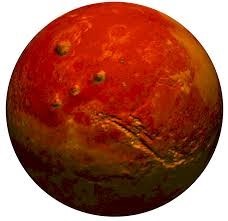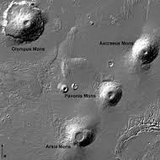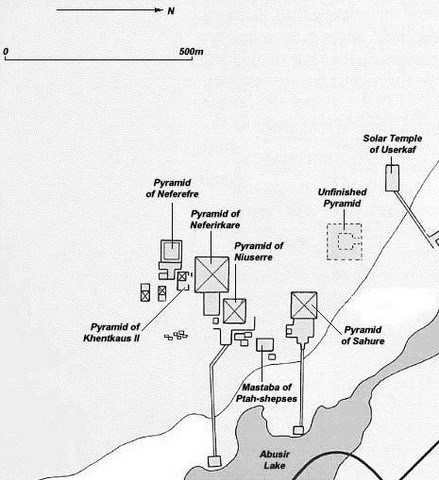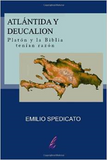The Pyramids of Giza, the Belt of Orion and Three Volcanoes on Mars
Dedication
This work is dedicated to Donald Patten, Seattle, whom I met several times, author of the theory that Mars approached Earth every 54 years; sadly, he died at beginning of 2014. Dedicated also to Alfred De Grazia, a genius in the analysis of the past, whose study of the relations between Mars and Moon has influenced this work. Remembering the demise of such a giant mid 2014, a few days after this author had visited him in his house in Villaines-la-Gonais.
Abstract
Here we consider an alternative approach to the one of Bauval and Gilbert, who claimed that the three Giza pyramids are aligned in similarity to the three main stars of the Orion belt. We show that there exists a better fitting alignment with certain three volcanos on Mars. Such volcanos were visible from Earth between 7000 and 700 BC. During that period, following ideas of Patten, Ackerman and this author, Mars approached our planet every 54 years. Our proposal is supported by the etymology of the word “pyramid” and by the existence of 54 niches, 27 on each side, along the stairs of the Great Gallery in the Cheops pyramid.
1. Pyramids of Giza, planet Mars and the Orion Belt

Below, we give images of the Giza Pyramids, the three volcanos of Mars and the Orion Belt, from NASA pictures available in internet . Then we evaluate the associated distances and angles for a comparison with the data in Gilbert and Bauval, giving a new proposal that favors the Martian volcanos.
Below an image of Mars, showing Valles Marineris, the three volcanos that we are considering and Mons Olympus. The volcanoes’ names are Ascraeus Mons, Pavonis Mons, Arsia Mons. The distance between two continuous volcanos, measured from the crater centers, is about 800 km; their basis extends over a few hundred km, much less than the 600km of Mons Olympus.


A closer image of the three volcanos follows, which we use to calculate the distance ratios and their angle of alignment, assuming that they lie on a plane. From their known distances and the apparent alignment we calculate also the angle between their tangents to the Martian sphere.

Next, an image of the Orion Belt, where the larger stars are named Al Nitak, Mintaka, Al Nilam. As a new note, these names may possibly be related to the rivers Tanai (Nitak by methatesis), Mintaka (a river whose source is near Mintaka pass north of Hunza valley in Pakistan, ending as Tarim in the Lob Nor desert ) and Nile. These rivers seem to define the area under control of Sem, Cam, Iafet, the three well known sons of Noah. The Orion constellation is one of the most spectacular in the night sky. To it belong some very bright star as Rigel, Betelgeuse and Bellatrix.
2. Approximate evaluation of distances and angles
We now estimate the distances, measured in millimeters using a ruler, between the estimated centers of the considered images; notice that only the ratios are of interest. The obtained values might be improved, albeit we deem by only a little, using more sophisticated techniques.
From Cheops to Chephren, 53 mm, from Chephren to Mikerinos, 47 mm
Distances ratio, with 3 digits: 1.13
Distance between the two volcanos on the left: 53 mm, between the two volcanos on the right: 59
Distances ratio, 1.11
The stars of Orion Belt appear equally distant, distance measured as 53 mm, their ratio equal to 1.
From the distance parameter, the three volcanos better approximate the Giza pyramids.
Let us consider now the angle between the half ray that joins the summits of the Cheops and Chephren pyramids, and the one that joins the summits of Chephren and Mikerinos pyramids. We evaluate it by a protractor. The angle between pyramids is about 9°. The angle related to Orion Belt is 26°. The one related to the volcanos, assumed to lie on a plane, is about zero, showing an almost perfect alignment. Thus we claim that even for angles the volcanos give a better approximation to the Giza system, the error being 9° against 17° of Orion Belt.
We notice however that the volcanoes’ centers are located about 800 km away, not a short distance compared to the Mars radius, which is about 3390 km; thus they do not lie on a straight line, but on a circumference arc. We may therefore consider the angle as derived from the angle between the tangents to the Martian sphere at the point where the volcanos centers are located (assumed for simplicity to lie on a Martian perfect spherical surface). We also assume such centers to lie on a same plane passing through the center of Mars. From the 800 km distance and the Mars radius, the angle defined by the arc between two nearby volcanoes is measured in radiants as 800/3390, say 0.236. The corresponding value in degrees is about 13.5, one radiant corresponding to about 57.25 degrees. The angle between the tangents is equal, by elementary geometry, to the angle associated to the considered arc, say its value is 13.5 degrees.
Thus we have the following values for angles: 9° for pyramids, 13.5° for volcanos and 26° for Orion Belt. The volcanos therefore provide also a better approximation to the Giza values, the error being 4.5 degrees, against 17 for the Orion Belt. The 4.5 degrees error might be explained by tectonic events on Mars between the time the pyramids were built and now. The likely cause was the loss of the Mars core, claimed by Ackerman (2001a, 2001b), which exited Mars by the Valles Marineris opening. In a forthcoming paper we will date this event at 3161 BC, the year of Noah’s Flood, also proposing the location where Noah built his ark, a location never considered before but leading to a full validation of Biblical statements.
3. Considerations on Orion and Mars in relation to Giza
The reasons given by Bauval and Gilbert for a relationship between the Giza pyramids and the three stars in the Orion Belt are complex, partly astronomic, partly esoteric, partly related to the possible arrival of intelligent beings from the Orion belt at the beginning of the Egyptian civilization. On the existence on Mars of artificial structures possibly created by intelligent beings, see Piccaluga (2009).
Our own reasons refer to a special period of planet Mars, that according to the scenario developed by Spedicato (2010, 2013, 2014), Patten (1988), Ackerman (2001, 2001), partially De Grazia (1984), went probably through the following evolution:
- Since a time not now known till about 9450 BC, when the last Ice Age ended very rapidly, Mars was a satellite of Earth, moving on an orbit with a diameter of about one million km, at the moment when the Moon’s capture took place. Mars loomed in the sky with an angular size similar to the present lunar size, or Sun’s size; it was endowed with water and probably life existed there, see Ginenthal (2002) and the quoted Piccaluga (2009)
- from 9450 till about 7000 BC, Earth had a second satellite, the Moon, captured about 9450 BC from a body whose mass was about ten times Earth mass, see Spedicato (2010). This body can be identified with the Greek Metis, or the Babilonian Marduk or other deities. The Moon after its capture moved on an orbit closer to Earth than now, of a radius of about 270.000 km. It loomed in the sky one and a half times bigger than Sun or Mars, a fact that inter alia made eclipses more terrifying than now, due to the complete covering of the Sun’s disk and the longer duration. Possibly here is the origin of the terror that eclipses provoked to the ancient peoples.
- At about 7000 BC we can date Metis impacting over Jupiter, in the region where the Red Spot is now to be seen, see Ackerman (2001, 2001), tracing a deep crater wherefrom part of the Jupiter mass was expelled, particularly from its core. Mass from Jupiter impacted Mars, breaking its gravitational tie with Earth. Mars was impacted opposite the hemisphere where the Tharsis Bulge is located. Here we also find Mons Olympus, the three volcanos here considered and the fracture called Valles Marineris.
- Between 7000 BC and 700 BC Mars moved along an elliptic orbit that saw it passing close to Earth every 54 years, at a distance even smaller than the Moon’s distance, see Patten (1988) and De Grazia (1984), who inter alia established that Aphrodite is the Moon and not Venus. Every 108 years the close passage took place either by day or by night. Total number of passages probably 100, the last one characterized by an interaction with Venus that made the orbits of both these planets almost circular, see the mathematical analysis of Dixon (2002). Number 100 corresponds to the 100 names of God in the Koran, one being known only to wise men.
- When Mars was closest to Earth, its angular size could be of several degrees, allowing clear sight of aspects of its surface, especially of the volcanos and Valles Marineris
- Due to gravitational tide effects when Mars was closest to Earth, that increase inversely with the cube of the distance, many Martian volcanos probably erupted. Valles Marineris would also get larger, leading to that final effect that was the loss of the Mars core, followed by the Spring of 3161 BC.
- The three volcanos here considered probably dominated the Martian landscape. Their eruptions were likely more violent than those of Mons Olympus, since they were close to Valles Marineris whose opening acted as a pusher of magma. If Mars passed at 100.000 km least distance (a distance well over the Roche limit that for Earth is about 18.000 km), they were seen under an angle of about 0.92 degrees, say 55 primes, about twice the present angle under which Moon or Sun are observed. Thus they were neatly separated, and the fire of their eruptions was well visible, good visibility also for a passage even at about one million km.
- Assuming that the close passage stimulated eruptions, the volcanoes’ fire and smoke, well visible from our planet, would have made a terrifying event for the observers. The three volcanos were probably characterized by sacredness, to be replicated in their form on Earth by three somewhat similar structures, the pyramidal form being chosen in view of the likely triangular form under which the volcanic flames were observed. Additional meanings were probably imbedded in the pyramids. Moreover pyramids may have been used for other purposes.
4. Other relations between Giza and Mars
The number 54 claimed as the number of years between two Mars passages is found in an important feature of the Cheops pyramid, which was never explained satisfactorily. That is the existence of 54 niches on the sides of the Grand Gallery, 27 on the right, 27 on the left, see Patten and Spedicato (2000, 2002) and the discussion in Alford (2007), where pictures are provided.
It turns out also that the etymology of the Greek word pyramis leads to the possible origin of such structures. This name in our context reflects exatly the original meaning in Greek, wholly differing from the several meanings proposed in the literature and taken from non-Greek languages. It is now indeed usually proposed by Egyptologists as a derivation from Old Egyptian peremus, a word appearing in the Rhind papyrus to indicate something that is elevated, a fact well appropriate to pyramids, that in height were beyond anything known built by man. Here we just notice that the Babel Tower, if completed, could have been higher. It was destroyed in a special way by an event that we identify with the passage of Typhon over it; we also will claim, in a paper to appear soon, that the builder was Sargon the Great, to be additionally identified with the Nonus of Herodotus and the Nimrud of the Bible, kings who lived at the time of Job and Abraham. Typhon exploded as a super Tunguska event over the Eastern Delta.
Now the original meaning of pyramis is somethingh having the shape of fire, say a shape that is usually associated to a triangular form, to a pointed form, see eg the Dizionario etimologico of Ottorino Pianigiani, edited in 1907 by Società Editrice Dante Alighieri, online by Francesco Bonomi, 2008. See also Dante claiming: lo maggior corno della fiamma antica. This meaning stemming from the shape of fire is well adapted to our association with erupting volcanos.
5. Other images
We now consider other images from ancient Egyptian monuments or structures. The first image is from the Senemut tomb. He was a famous architect, of the time of Queen Hatshepsut, of whom she was possibly a lover. We see many stars, or objects of stellar form. In the center there are three perfectly aligned stars, in front of another star, suggesting our three volcanos plus Mons Olympus. The central star of the triplet is imbedded in three oval form structures, pointing towards Mon Olympus. A certain explanation is lacking, but the structure might represent the smoke-flame emissions from volcanos, pointing towards Mons Olympus possibly under the action of Coriolis forces. Notice the pointed form of the oval structures, suggesting the typical form of flames.
One can notice several other triplets, especially the one of not well aligned stars over the head of god Osiris. We are unable to give an explanation and we are not aware if it has been given in the literature.
The second image comes from the very old Pyramid Texts, found in the Unis pyramid, a pharaoh of the fifth dynasty. We see three stars perfectly aligned, that may be related to the three volcanos. We give an additional observation, probably never made in the literature, namely that stars in Egyptian paintings are represented with 5 points. A five pointed star is associated naturally to planet Mars, fifth body counted from Sun, after Mercury, Venus, Earth, Moon. Thus such stars may have been represented having in mind the dominant role of Mars in the sky for several millennia. A 6 point star would represent Jupiter, king of planets and of gods for reasons that cannot be discussed here. That is the star adopted by David, Solomon, the Moghuls and other kings, who had a high esteem of themselves and their role of world masters.
Third image is from Abusir, fifth dynasty. We see two pyramid triplets, one consisting of larger pyramids, one of smaller. The pyramids in the large triplet form an angle of 28° and the distance ratio is about 1.14. They correspond therefore to the volcanos in distances, but differ in the angle.
Image from Senemut tomb

Pyramid of Unis

Abusir complex

6. Orion, who are you?
We have seen that the three Giza pyramids are better oriented towards the three Martian volcanos than the three stars in Orion belt. The inaccurate alignment towards the Orion Belt has been noticed before, see for instance La Violette (2005), who claims an error of about 10% in distances and 32% in angles, and Collins ( 2007 ), who notices that a perfect alignment would occur with three stars in Cycnus. Collins’ proposal was rejected by Alice Smith, see her website The hidden records. Since there are thousands of stars visible to naked eye, one can probably find many triplets with better alignment to the Giza pyramids. Now we consider a possible relation between Mars and Orion, in the context of Mars relations with Earth.
Word Orion, in Greek Orion with initial Omega, has an intriguing etymology. From the quoted Dizionario Etimologico Ottorino Pianigiani, it is related to the following words:
Celtic URIA = rain (possibly related to French orage or Italian uragano?)
Sanskrit UR = water, variants VARA = rain, VARUNA = god of waters, and urine, that is a kind of water flowing as well from a certain height.
In Biografia universale antica e moderna, 1838, a relation is also given to Greek OUROY = frost.
The above etymologies, whose correctness is not certain, do not appear to bear a relationship with the giant hunter Orion or the constellation with the same name. We propose that they should be understood within a special and unique episode of Mars interacting with Earth, and that the better known names came as a late development. The special event in Mars’ life is the one considered by Ackerman (2001), who describes the loss of the Mars core exiting from Valles Marineris (an event corresponding to the lingam exiting from the yoni, where correlation with human anatomy is only apparent) to become planet Mercury. The event took place, from three arguments to be presented elsewhere, in year 3161 AC, a date different from the one in Ackerman. This event caused the Biblical Flood, characterized by two never explained events, said to be the opening of the fountains of the deep and of the high.
The fountains of the deep are fractures in the oceanic crust, whose depth is just a few km, due to the close passage of Mars and its core, wherefrom magma comes leading to water evaporation and warm rains. The fountains of the high are water coming from Mars, where the exit of the core led to the removal of the waters of the Martian oceans, which partly survived the effects of the impact of Jovian material about 7000 BC. This water was removed quickly, leaving scars and canyons on Martian surface, and partly falling on Earth, partly dispersing along the Martian trajectory. These waters from the high fit very well with the original etymology for Orion. Their color was probably affected by Martian dust, becoming the color of urine. They were possibly saltier than terrestrial oceanic waters. They may have endured in places where tsunamis would not reach, as in high plateaus, salty lakes. We find them for instance on the Tibetan and the Nevada plateau. Planet Mars sending water from the high could therefore be, in the Greek tradition, the original Orion. We cannot say if a similar correspondence might exist in the Egyptian traditions.
After the Flood, memory of the event went to the constellation then called Orion, especially if Mars transited in front of it when it lost its core and started the Flood. We leave to study in the future why Orion was considered a great hunter. Notice only that a myth stating that Orion fell and became double may be the description of Mars losing its core.
Thanks
For remarks and information thanks to Luigi Lehnus, Michele Manher, Giuseppe Marinoni, Rosario Vieni, and especially Anna Bacchi, who kindly provided several images.
Bibliography
John Ackerman, Chaos, Infinity, 2001
John Ackerman, Firmament, Infinity, 2001
Alan Alford, La piramide dei segreti, Newton Compton, 2007
Robert Bauval and Adrian Gilbert, The Orion mystery: unlocking the secrets of the pyramids, Heinemann, 1994
Andrew Collins, The Cygnus mystery, Watkins, 2007
Alfred De Grazia, The disastrous love affair of Moon and Mars, Metron, Princeton, 1984
Laurence Dixon, On Velikovsky’s orbits, a mathematically possible concept, Proceedings of the Conference Fifty years after Worlds in Collision by Velikovsky: classical and new scenarios on the evolution of the solar system, E. Spedicato and A. Agriesti editors, University of Bergamo, 73-77, 2002
Charles Ginenthal, Sulle idee scientifiche di Immanuel Velikovsky, Proceedings of the conference: New scenarios on the evolution of the solar system and consequences on history of earth and man, Report Miscellanea 2002/2, University of Bergamo, Emilio Spedicato and Adalberto Notarpietro editors, 79-111, 2002
Paul La Violette, Earth under fire, Bear & Company, 2005
Donald Patten, Catastrophism and the Old Testament, Median Publishing, 1988
Donald Patten and Emilio Spedicato, On the numbers 54 and 108, in Proceedings of the conference: New scenarios on the evolution of the solar system and consequences on history of earth and man, Report Miscellanea 2002/2, University of Bergamo, Emilio Spedicato and Adalberto Notarpietro editors, 130-142, 2002
Ennio Piccaluga, Ossimoro Marte, Acacia Edizioni, 2009
Emilio Spedicato, On the recent origin of the Moon, a four-five body scenario for a capture event and its mathematical modeling via nonlinear optimization, in Quantavolution, Challenges to Conventional Science, Metron, Ian Tresman editor, 171-
186, 2010
Emilio Spedicato, From Nibiru to Tiamat, an astronomic scenario for earliest
Sumerian cosmology, Actual problems of aviation and aerospace systems: processes, models, experiments, Kazan, 237, 18, 25-35, 2013
Emilio Spedicato, About modeling interaction of Earth with large space object:
the with explosion of Phaethon and the subsequent evolution of mankind, part
I, Actual problems of aviation and aerospace systems, Kazan, 38, 19,42-54, 2014
Emilio Spedicato, About modeling interaction of Earth with large space object:
the explosion of Phaethon and the subsequent evolution of mankind, part II,
Actual problems of aviation and aerospace systems, Kazan, 39, 19, 46 61, 2014
Books

Abbiamo amato Puccini
...because we all love Puccini... (in Italian)







